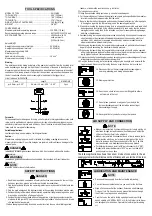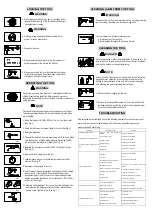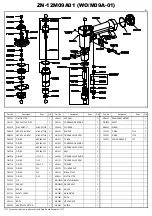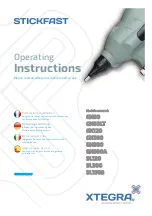
LOADING THE TOOL
WARNING
•
Do not place your hand or any part of your body in the
fastener discharge area of the tool when connecting or
disconnecting air supply.
WARNING
•
Never point any operational fastener driving tool at
yourself or at any other person.
1. Disconnect air hose.
2. Place decorative upholstery nails into the template for
perfect alignment of the nail into the ZN-12M.
3. When you press the tool over the template the magnet
inside the nose will pick the nail and seat it properly for
straight and effortless driving of nails.
OPERATING THE TOOL
WARNING
Protect your eyes and ears. Wear z87.1 safety glasses with side
shields. Wear hearing protection. Employers and users are
responsible for ensuring the user or anyone near the tool wear this
safety protection.
NOTE
Check and replace any damaged or worn components on the tool.
The safety warning labels on the tool must also be replaced if they
are not legible.
1. Add a few drops of UNOCAL RX22 or 3-in-1 oil into the air inlet.
(See Fig. 1)
2. Attach a high flow quick connect fitting to the tool. (See Fig. 2)
3. Empty the magazine.
4. Connect the tool to an air compressor using a 3/8" I.D hose. Make
sure the hose has a rated working pressure exceeding 200 PSI
(13.8bar) and a female quick coupler. (See Fig. 3)
5. Regulate the air pressure to obtain 70 PSI (4.8 bar) at the tool.
(See Fig. 4)
6. Disconnect the air supply from the tool.
7. Load fasteners into your tool following the instructions in this
manual. (See Fig. 5)
8. Reconnect the air supply to the tool.
9. Test for proper fastener penetration by driving nails into a sample
piece of wood. If the fasteners do not achieve the desired
penetration, adjust the air pressure to a higher setting until the
desired penetration is achieved. Do not exceed 110 PSI (7.6 bar)
at the tool. (See Fig. 6)
10. Measure nail head height first. Loose the screw and adjust the
mouthpiece to the proper position that doesn’t hurt nail head
surface, screw tight the screw. (See Fig. 7 )
CLEARING A JAM FROM THE TOOL
WARNING
Disconnect the tool from air compressor before adjusting, clearing
jams, servicing, relocating and during non-operation.
Fastener jammed in fastener discharge area:
•
Disconnect tool from air hose.
•
Grab jammed fastener with pliers and remove.
CLEANING THE TOOL
DANGER
Never use gasoline or other flammable liquids to clean the tool. Va
pors in the tool will ignite by a spark and cause the tool to explode
and result in death or serious personal injury.
NOTE
Solvents used to clean the nose of the tool and contacr safety trip
mechanism may soften the tar on the shingles and cause the
buildup to be accelerated. Make sure to dry the tool thoroughly
after cleaning and before operating the tool again.
1. Disconnect the air supply from the tool.
2. Remove tar buildup with kerosene #2 fuel oil or diesel fuel. Do
not allow solvent to get into the cylinder or damage may occur.
Dry off the tool completely before use.
TROUBLESHOOTING
Stop using the tool immediately if any of the following problems occur. Serious personal
injury could. Any repairs or replacements must be done by a qualified person or an
authorized service center only.
PROBLEM PROBABLE
CAUSE
REMEDY
Air leaking at trigger valve area.
Air leaking between housing and nose.
Air leaking between housing and cap
assy.
O-rings in trigger valve housing are
damaged.
Loose screws in housing.
Damaged to bumper.
Damage to bumper.
Loose screws.
Damaged seal.
O-rings must be replaced.
Screws need to be tightened.
O-rings must be replaced.
Bumper needs to be tightened.
Screws need to be tightened.
Seal needs to be replaced.
Tool skips driving fastener.
Worn bumper.
Dirt in nose.
Dirt or damage prevents fasteners from
moving freely in magazine.
Inadequate air flow to tool.
Worn O-ring on piston or lack of lubrication.
Damaged O-rings on trigger valve.
Air leaks.
Cap seal leaking.
Bumper needs to be replaced.
Clean.
Magazine needs to be cleaned.
Fitting hose or air compressor needs to be
checked.
O-ring needs to be replaced. Lubricate.
O-rings need to be replaced.
Screws and fittings need to be tightened.
Seal needs to be replaced.
Tool runs slow or has loss of power.
Tool not lubricated sufficiently.
Broken spring in cap assy.
Exhaust port in cap is blocked.
Tools needs to be lubricated.
Spring needs to be replaced.
Damaged internal parts need to be replaced.
Fasteners are jammed in tool.
Driver nozzle worn or damaged.
Driver is damaged.
Fasteners are not correct size.
Fasteners are bent.
Magazine or nose screws are loose.
Replace driver nozzle.
Replace driver.
Fasteners recommended for tool must be used.
Replace with undamaged fastener.
Screws need to be tightened.
Solvent
Fig.1
Fig.2
Fig.3
Fig.4
Fig.5
Fig.6
Fig.7






















